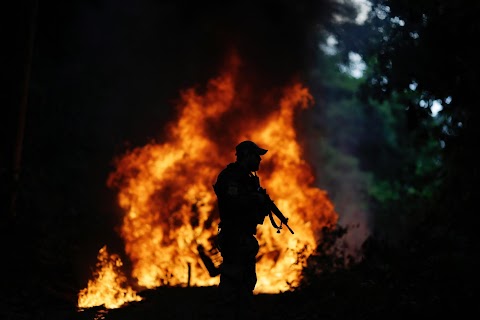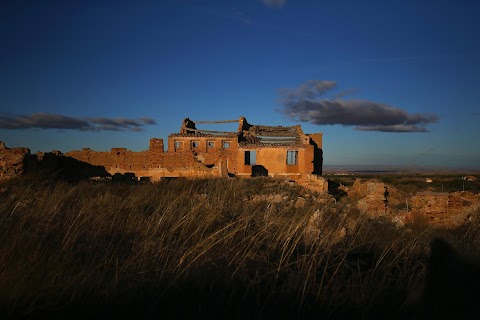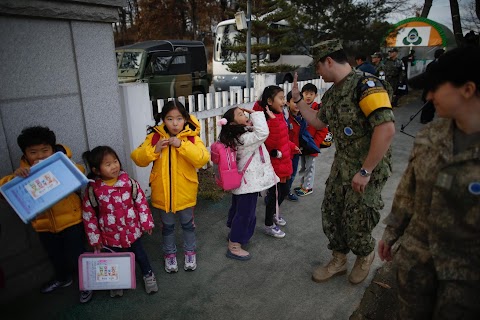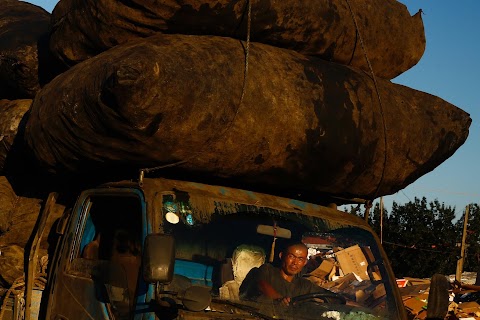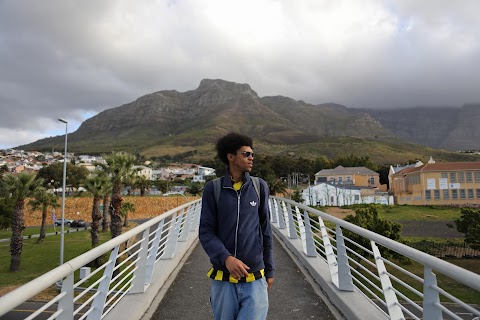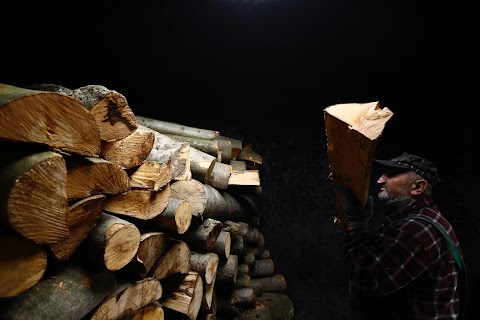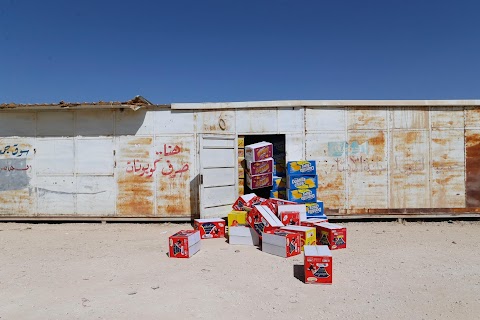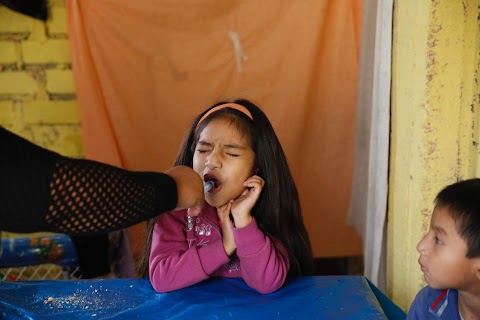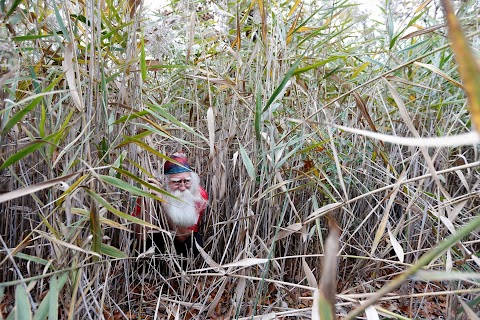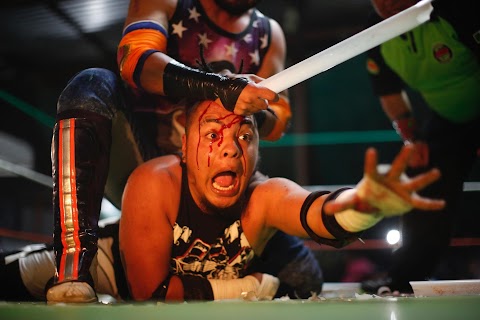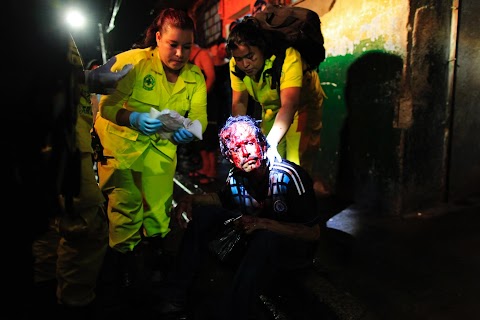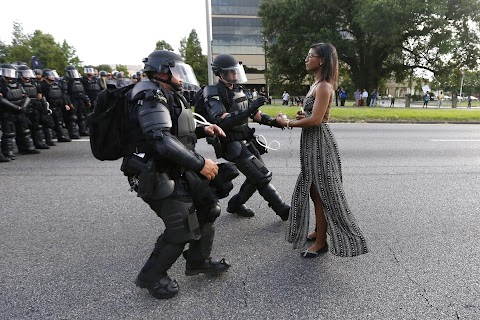
2016: A picture and its story
From Syria's festering conflict to the Bastille Day attack in Nice, Reuters photographers have been on the scene to record the biggest news stories this year.
Here our photographers give their accounts of the events behind some of the most striking images of 2016.
Story
Jonathan Bachman: A woman standing calmly, her long dress moving in the breeze, two police officers in full riot gear make their move.
I was on assignment for Reuters in Baton Rouge to cover the protests over the fatal police shooting of Alton Sterling.
Moments before I captured this image of Ieshia Evans I had my back turned photographing face-to-face confrontations between the police and the demonstrators.
I heard someone behind me say something like “don’t stand there, they are arresting people in the street.”
I turned and looked over my right shoulder and saw this woman standing in the road. I knew right away what was about to happen. The police were going to arrest her. I quickly moved and took the shot.
When I came back to my car and looked through my take I knew I had a strong image. However I didn’t anticipate that the image would go viral. I am grateful that it has stimulated a discussion about an important issue in this country.

Kai Pfaffenbach: When Usain Bolt prepared for his 100m semi-final I decided to play with slow shutter speed for that race.
I set my camera (shutter speed) to a 50th of a second and was waiting for the moment when he passed my position.
In this very right moment he looked to his left with the proud smile and my first thought was: 'hopefully I got this sharp.'
Well, I've been a lucky bunny in this case but I still would not have imagined at this moment that this picture would go viral and get worldwide recognition.

Rodi Said: When U.S.-backed forces seized Souad Hamidi's village in northern Syria from Islamic State, the 19-year-old swiftly tore off the niqab she had been forced to wear since 2014 and smiled.
"I felt liberated," Hamidi said after swapping her black face-covering veil for a red headscarf.
"They made us wear it against our will so I removed it that way to spite them."
I was heading to villages that had been retaken by Syrian democratic forces (SDF), and my arrival coincided with the arrival of Hamidi back to her home.
Am Adasa had been under the militants' control since 2014, when Islamic State proclaimed its caliphate straddling Syria and Iraq. Under Islamic State, life was strictly regulated, Hamidi said, including dress codes.
"They would punish people who did not follow their rules, sometimes forcing them to stay in dug-out graves for days," she said. "Since they (SDF) took control, we are living a new life."
Sitting in her family home, Hamidi said she still fears Islamic State may return one day.
"I want to erase Daesh from my memory," she said.
"I hope every area controlled by Daesh is liberated, that people are free of them and can live like we do now.
For me this picture expresses Hamidi strength of personality, her reclaiming freedom from the blackness that was forced upon her. Its the moment when one overcomes fear of religious persecution.

Amit Dave: I was shooting daily life pictures in Ahmedabad when I spotted workers pulling heavy electric cables and thought they could make an interesting frame. The light wasn’t good and I waited for it to improve.
The workers' children were running about playing by the roadside, but there was one child who was sitting alone, and I wandered over to see why.
Fifteen-month-old Shivani was tugging at a plastic tape her mother had wrapped around her leg and tied to a rock at the building site.
Barefoot and caked in dust, she spends nine hours a day in temperatures topping 40 degrees Celsius attached to the tape marked "caution".
Sarta Kalara, her mother, said she has no option but to tether Shivani to the stone, despite her crying, while she and her husband work for 250 rupees ($3.8) each a shift digging holes for electricity cables in the city.
"I tie her so she doesn't go on the road. My younger son is three and a half so he is not able to control her," said the 23-year old.
“This site is full of traffic, I have no option. I do this for her safety."
Parents said their children usually stay with them until they are seven or eight, when they are sent to live with their grandparents.
Kalara, holding Shivani as the plastic tape dangled from her leg, said managers had turned a blind eye to her plight.
"They don't care about us or our children, they are only concerned with their work."

Ueslei Marcelino: 'Silva was seven months pregnant when an ultrasound showed her unborn baby's head had stopped growing.
Her 3-month-old daughter Maria Giovanna has microcephaly, a deformation characterised by abnormally small heads that can also include brain damage.
I spent some time with Silva and her family, watching her look after her daughter.
"I never imagined my daughter could be born with a defect,” Silva said.
"When I saw her the first time I cried ... I saw my perfect daughter and thanked God. It was a feeling of love, happiness."
The family has been supportive towards the couple. They treat Maria Giovanna as they would any other baby.
Such an assignment is delicate, the family are anxious about what’s happening and it’s important to be sensitive and respectful. I always arrive with my camera lowered and speak to people first. Everyone needs to be listened to.
Silva has set up a phone-messaging group with other mothers whose babies have microcephaly.
They share experiences and support each other. She is hopeful that her daughter will not suffer any severe consequences in the future and that Maria Giovanna will grow up to walk, talk and play with other children. "I cannot believe it when the doctors say she will not walk," she said. "I need to believe that everything will be all right."
In the months that followed I kept in touch with the family; their lives are not easy. Kelly left her job to take care of their daughter full-time. Her husband has a temporary job, but he earns less than $200 per month.
Maria Giovanna needs a lot of medicine and the family doesn’t have enough money to pay for her treatment. The family hopes to receive help from the government or a social programme, but say they haven’t received any assistance yet.

Brian Snyder: To some, it was as if she had met a celebrity rock star. To others, this woman looked pretty terrified.
In fact Robin Roy is one very eager supporter of U.S. President-elect Donald Trump.
Wearing a t-shirt reading “Obama, You’re Fired. Vote Trump 2016,” she had waited for a chance to meet Trump in person at the rally. Then the New York real-estate mogul and reality TV star shook her hand and talked to her.
Excited would be an understatement.
All candidates with their eye on the White House greet supporters along the “rope-line” at the end of events like these. It’s a chance for voters to shake the hand of the candidates or pose for a selfie.
The other people in the photo are also supporters, including Roy’s daughter on her left.
Photographers are fairly restricted by the campaign during Trump events. Most images are taken from the main podium, at the back of the hall across from the main stage, with long lenses (400mm).
After the speech, a small group of photographers were escorted to the stage to document Trump making his way along the rope-line. I took this photo with a shorter lens (50mm) from the stage looking over Trump’s shoulder.
The fact that every day is unique is one of the truly fun parts of this job.
Roy remained an unwavering Trump supporter throughout the campaign. "We realized that Trump was one of us and he didn't hide that fact. Is he perfect? No, but he sincerely seems to care about the people. He doesn't talk down to us or make himself seen better."
Nearly a year after her meeting with Trump, and awaiting the beginning of the Trump presidency, she says, "I hope he comes through with most of his promises and brings this country together to stop the political nonsense."

Toby Melville: I hate flying, so when I was asked if I fancied a day trip from a US air force base in Britain to near the border with Crimea, to photograph a mid-air refuel of US fighter bomber planes, I did initially hesitate.
I have been sick many a time on previous assignments; flying in military helicopters over Baghdad, in planes hugging mountains in Kosovo and on six-seater propeller planes bouncing up and down through electrical storms in the Chilean Andes mountains. But the chance to shoot from such a unique viewpoint soon over-rode all my queasy qualms.
A 3.30 alarm call marked the beginning of a 19-hour working day. Eight hours of the shift were spent mid-air in the 50-year-old hulk of a noisy, rickety and dark behemoth of a fuel tanker plane.
The USAF crew members gave me several opportunities to shoot the Raptor fighter jets performing their miraculous seeming manoeuvres during the day.
The Raptors flew at hundreds of knots, just metres from us and with precision accuracy, the umbilical-like line would drop out of the bottom of our plane and lock onto a miniscule-looking aperture on the top of the F22's.
This frame shows a pilot preparing to receive the fuel-line. With the bonus of an optically super window to shoot through, together with great visibility on the return leg to Britain from Romania, I was satisfied with the pictures.
Thankfully on this trip I managed to keep my composure and during the debrief, still trying to hide wobbly legs, I didn’t mention to any of the pilots or crew members that I once even puked on an escalator - that’s how bad my motion sickness is!

Bassam Khabieh: He looked so lonely lying alone on the table, his cloths stained with blood. Mahmoud Baraka, 11, was killed during shelling of Douma, part of rebel-held Eastern Ghouta, an area the government is trying to recapture. Baraka’s mother and his brothers were also wounded in the bombardment. His father and two uncles died in attacks last year.
That day, the city suffered several air raids. I tried to go to the targeted locations but as a new wave of shelling started I waited in a building for the attack to end. Then I went to the civil defence point where they brought victims to prepare them for burial.
Baraka had been brought there; the workers were waiting to wrap his body in a shroud until one of his relatives could attend. A civil defence member tried to straighten the child's leg, but they were already stiff and stayed bent.
A neighbour went to look for Baraka’s grandfather, who was working on the outskirts of the city, so he could collect his grandson’s body. I waited for the grandfather, but the civil defence team decided to transfer the child's body to his family's home before the grandfather arrived.
We went with the boy's body to his families’ house. The grandfather arrived; he could not believe that another grandson, the last son of his dead son, had died. Tears ran down his face.
Baraka’s grandmother and other relatives were weeping and screaming, "Why did you leave, oh Mahmoud, why did you leave," the atmosphere was electrified.
The family mourned at home and then he was carried to the local mosque, where prayers were said over the body. The neighbourhood kids stood around the body to catch a last glimpse of their dead friend. The body was transferred to the cemetery and buried.

Czar Dancel: 'When the image of Olayres weeping as she cradled the body of her slain partner went viral in the Philippines, President Rodrigo Duterte called it melodramatic. He mentioned the image of Olayres in his state of the union address and said media had tried to portray it as being like the Michelangelo's Pieta, the sculpture of Mary holding the body of Jesus.
Six were assassinated on that night in Manila, among them Michael Siaron, Olayres’s 29-year-old partner, who was shot dead by unknown assailants on motorcycles.
Over recent months I have been regularly covering the killings of suspected drug dealers. During the night journalists and photographers from different media organisations work as a team.
Siaron’s was the last of several deaths we covered that night. It is always shocking to arrive at the scene of a death. I took a couple of images before I noticed Olayres cradling Siaron’s body.
A piece of cardboard was left next to his corpse with the word "pusher" written on it.
"A friend called out that Michael was shot. I ran out to see him," Olayres said in a rundown part of the capital's Pasay area.
Olayres concedes that Siaron was a drug user but says it is impossible he was a dealer because they were too poor and could barely pay for their next meal.
"They must kill the ones who don't deserve to live anymore, the ones who are a menace to society. Because they cause harm to others. But not the innocent people," she said.
"I don't need the public's sympathy. I don't need the president to notice us. I know that he doesn't like this kind of people. But for me, I just hope that they get the true offenders."
Asked if she had a message to tell Duterte, she said: "kill drugs, not people."

Goran Tomasevic: I had been to the Tahrir district of eastern Mosul several times while covering the campaign by Iraqi forces backed by U.S.-led air strikes to retake the city from Islamic State militants.
Covering battles is tough and in this case, it was difficult to get to the frontline at times, but on this day we managed. When we arrived it seemed calm and quiet.
Soon after a car blew up in a suicide bombing in an Islamic State counter-attack to the forces' push into Mosul. There were casualties, children screaming, and several nearby houses were destroyed. There were also clashes.
I have covered many conflicts in my career, but what has struck me in Mosul is the number of car bombings.
The fighting comes in waves and when things eventually quietened down, I saw a group of civilians making the most of a break in gunfire to come out onto the streets.
They were both young and elderly, and felt safe enough to leave their homes with few belongings, walking carefully but calmly towards where I was standing capturing the scenes around me.
Suddenly an air strike targeted Islamic State positions a few hundred metres away behind them. It was close and total panic ensued. People were screaming, ducking and running away as the plumes of smoke rose nearby. They quickly ran for whatever shelter they could find.
I heard the plane just before the airstrike, and from experience knew I had little time. These things happen fast and you have to act quickly. First you have to make sure you are safe, then stay focused so you can get the shot. You get your lens ready and stay calm.
It was one airstrike and residents waited it out before finding other shelter. I eventually moved to another location to continue covering the fighting.

Eric Gaillard: 'I was at home, on holiday after a gruelling few weeks covering the Euro 2016 soccer championships, when a colleague called from Paris to say a truck had hit people in central Nice. I assumed it was a traffic accident - not something we would usually cover.
But then I received an alert on my phone, the local authorities announcing there had been an attack. I didn't stop to wonder what it was, I grabbed my cameras and set out on my motorbike.
I couldn't get through on my motorbike and, as I parked, I noticed there was a body lying on the curb. It was when I looked into my rearview mirror that I saw all the other bodies just behind me.
Around a dozen bodies, some already covered with tablecloths taken from nearby restaurants, lay on the seaside promenade. Police and soldiers - many pointing their guns - were still in a state of confusion.
The conditions were very difficult, it was dark, police trying to stop us work ... and some people there were aggressive. I understood. The situation was very chaotic.
The doll photo went viral on the Internet, often mis-captioned by the site, saying it showed a dead child beneath the foil emergency blanket. But in fact nobody knows for sure the age of the victim.
Given size of the victim, I don't think it was a child. I don't know why the doll is there. Was it a parent who was with a child - hence the doll? Did someone put the doll there at some point? Everyone has asked me.
When you go to a war you know it's a hostile environment, you expect to see some unpleasant things but I was very shaken by what I saw that night because the horror had come home to my city, Nice. The attack happened just 500 meters from my home and during France’s traditionally festive Bastille Day setting.'



